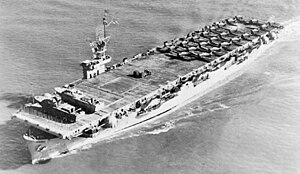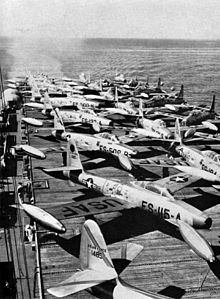
USS Admiralty Islands (CVE-99) was the forty-fifth of fifty Casablanca-class escort carrier built for the United States Navy during World War II. She was named after the Admiralty Islands campaign, a series of battles against isolated Japanese forces throughout the Admiralty Islands in the Bismarck Archipelago. The ship was launched in May 1944, commissioned in June, and served as a replenishment carrier, under the command of Capt. Edward Hastings Eldredge, in support of the invasion of Iwo Jima and the Battle of Okinawa. Postwar, she participated in Operation Magic Carpet. She was decommissioned in November 1946, when she was mothballed in the Pacific Reserve Fleet. Ultimately, she was sold for scrapping in January 1947.

USS Casablanca (AVG/ACV/CVE-55) was the first of fifty Casablanca-class escort carriers built for the United States Navy during World War II. She was named after the Naval Battle of Casablanca, conducted as a part of the wider Operation Torch, which pitted the United States Navy against the remnants of the French Navy controlled by Vichy France. The American victory cleared the way for the seizure of the port of Casablanca as well as the Allied occupation of French Morocco. The ship was launched in April 1943, commissioned in July, and served as a training and transport carrier throughout the war. Postwar, she participated in Operation Magic Carpet, repatriating U.S. servicemen from throughout the Pacific. She was decommissioned in June 1946, when she was mothballed in the Atlantic Reserve Fleet. She was sold for scrap in April 1947.

USS Munda (CVE-104) was the last of fifty United States Navy Casablanca-class escort carrier built for service during World War II. She was named after the Battle of Munda Point, which occurred on the island New Georgia, a part of the Solomon Islands in 1943. The ship was launched in May 1944, and commissioned in July, and served as an aircraft transport and as a replenishment escort carrier in the Pacific Theatre. Postwar, she participated in Operation Magic Carpet, the repatriation of U.S. forces from bases scattered around the Pacific. She was decommissioned in April 1946, when she was mothballed in the Pacific Reserve Fleet. Ultimately, she was sold for scrapping in June 1960.
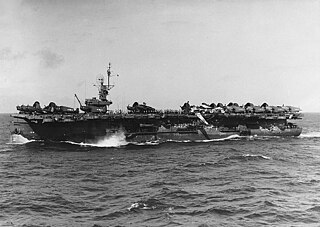
USS Attu (CVE-102) was a Casablanca-class escort carrier of the United States Navy. She was named after the Battle of Attu in the Aleutian Islands and was built for service during World War II. Launched in May 1944, and commissioned in June, she served as a transport carrier, ferrying aircraft, and as a replenishment carrier, supporting the Invasion of Iwo Jima and the Battle of Okinawa. Postwar, she participated in Operation Magic Carpet. She was decommissioned in June 1946, and sold for scrapping in January 1947. After a failed acquisition attempt by the Jewish Agency, she was ultimately scrapped in 1949.

USS Roi (CVE-103) was a Casablanca-class escort carrier of the United States Navy. She was named after the Battle of Roi, in which the United States captured the island of Roi-Namur. Built for service during World War II, the ship was launched in June 1944, commissioned in July, and acted as a transport and as a replenishment carrier. During the latter months of the war, she provided aircraft and supplies to the Fast Carrier Task Force, continuing until the end of the war. Postwar, she participated in Operation Magic Carpet. She was decommissioned in May 1946, and she was sold for scrapping in December.

USS Bougainville (CVE-100) was the forty-sixth of fifty Casablanca-class escort carrier built for the United States Navy during World War II. She was named after the Bougainville campaign, a prolonged action against Japanese forces entrenched in the island of Bougainville off Papua New Guinea. The ship was launched in May 1944, and commissioned in June, and served as a replenishment carrier in support of the invasion of Iwo Jima and the Battle of Okinawa. She was decommissioned in November 1946, when she was mothballed in the Pacific Reserve Fleet. Ultimately, she was sold for scrapping in August 1960.

USS Kwajalein (CVE-98) was the forty-fourth of fifty Casablanca-class escort carriers built for the United States Navy during World War II. She was named after the Battle of Kwajalein, in which American forces captured Kwajalein Atoll. The ship was launched in May 1944, commissioned in June, and served in support of the Philippines campaign. Later in the war, she served as a replenishment carrier, during which she was damaged by Typhoon Cobra. Postwar, she participated in Operation Magic Carpet, repatriating U.S. servicemen from throughout the Pacific. She was decommissioned in May 1946, when she was mothballed in the Pacific Reserve Fleet. Ultimately, she was sold for scrapping in January 1961.

USS Hollandia (CVE-97) was a Casablanca-class escort carrier of the United States Navy. She was named after the Battle of Hollandia, a successful amphibious operation during the New Guinea campaign. Launched in April 1944, and commissioned in June, she served in support of the Battle of Okinawa. Postwar, she participated in Operation Magic Carpet. She was decommissioned in January 1947, when she was mothballed in the Pacific Reserve Fleet. Ultimately, she was sold for scrap in December 1960.
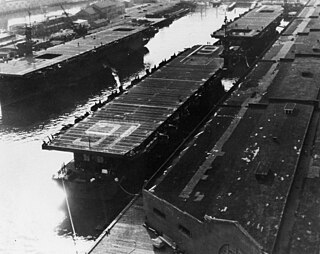
USS Makassar Strait (CVE-91) was a Casablanca-class escort carrier of the United States Navy. She was named after the Battle of Makassar Strait, an early naval engagement to the east of Borneo. Launched in March 1944, and commissioned in April, she served in support of the Battle of Okinawa. Postwar, she participated in Operation Magic Carpet. She was decommissioned in August 1946, when she was mothballed in the Pacific Reserve Fleet. Ultimately, she was used as a target, and she was accidentally run aground on San Nicolas Island in April 1961. Her wreckage survived until at least 1965.

USS Windham Bay (CVE-92) was the thirty-eighth of fifty Casablanca-class escort carriers built for the United States Navy during World War II. She was named after Windham Bay, within Tongass National Forest, of the Territory of Alaska. The ship was launched in March 1944, commissioned in May, and served as a replenishment and transport carrier throughout the Invasion of Iwo Jima and the Battle of Okinawa. Postwar, she participated in Operation Magic Carpet, repatriating U.S. servicemen from throughout the Pacific. She was decommissioned in August 1946, when she was mothballed in the Pacific Reserve Fleet. With the outbreak of the Korean War, however, she was called back to service, continuing to serve as a transport and utility carrier until 1959, when she was once again decommissioned. Ultimately, she was broken up in February 1961.

USS Cape Esperance (CVE-88) was a Casablanca-class escort carrier of the United States Navy. She was named after the Battle of Cape Esperance, an inconclusive naval engagement in support of the Guadalcanal campaign. Built for service during World War II, the ship was launched in March 1944, and commissioned in April, and served as a replenishment carrier. Postwar, she participated in Operation Magic Carpet. She was decommissioned in August 1946, when she was mothballed in the Pacific Reserve Fleet. However, she was recommissioned in August 1950, and assigned to become an auxiliary vessel as a part of Military Sealift Command. She was decommissioned again in January 1959, and ultimately, she was sold for scrapping in May 1959.

USS Kadashan Bay (CVE-76) was a Casablanca-class escort carrier of the United States Navy. It was named after Kadashan Bay, located within Chichagof Island. The bay in turn was named after Paul K. Kadashan, an Alaskan Indian who established a homestead incorporating the bay in 1915. Launched in December 1943, and commissioned in January 1944, she served in support of the Mariana and Palau Islands campaign, the Battle off Samar, and the Invasion of Lingayen Gulf. Postwar, she participated in Operation Magic Carpet. She was decommissioned in June 1946, when she was mothballed in the Atlantic Reserve Fleet. Ultimately, she was sold for scrapping in February 1960.

USS Marcus Island (CVE-77) was the twenty-third of fifty Casablanca-class escort carriers built for the United States Navy during World War II. She was named after an engagement on 31 August 1943 over Minami-Tori-shima, known on American maps as Marcus Island. She was launched in December 1943, commissioned in January 1944, and she served in the Mariana and Palau Islands campaign, the Philippines campaign, as well as the Battle of Okinawa. She spent the majority of her World War II as a flagship for various escort carrier formations, serving as the headquarters for Rear Admiral William D. Sample and Felix Stump. During the Philippines campaign, she participated in the Battle off Samar, the largest naval engagement in history, and during the Battle of Mindoro, she had multiple near-brushes with Japanese kamikazes. Post-war, she participated in Operation Magic Carpet, repatriating U.S. servicemen from throughout the Pacific. She was decommissioned in December 1946, being mothballed in the Atlantic Reserve Fleet. Ultimately, she was broken up in 1960.
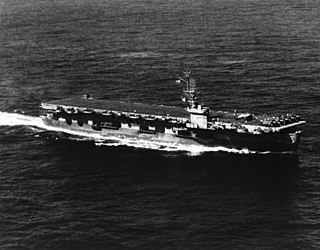
USS Nehenta Bay (CVE-74) was a Casablanca-class escort carrier of the United States Navy. She was named after Nehenta Bay, located within Gravina Island. Built for service during World War II, the ship was launched in November 1943, and commissioned in January 1944, and served in support of the Mariana and Palau Islands campaign and the Battle of Okinawa. Postwar, she participated in Operation Magic Carpet. She was decommissioned in May 1946, when she was mothballed in the Atlantic Reserve Fleet. Ultimately, she was sold for scrapping in June 1960.

USS Steamer Bay (CVE-87) was a Casablanca-class escort carrier of the United States Navy. She was named after Steamer Bay, located within Etolin Island, Alaska. Launched in February 1944, and commissioned in April, she served in support of the Invasion of Lingayen Gulf, the Invasion of Iwo Jima, and the Battle of Okinawa. Postwar, she participated in Operation Magic Carpet. She was decommissioned in January 1947, when she was mothballed in the Pacific Reserve Fleet. Ultimately, she was sold for scrapping in August 1959.

USS Shamrock Bay (CVE-84) was the thirtieth of fifty Casablanca-class escort carriers built for the United States Navy during World War II. She was named after Shamrock Bay, located within Baranof Island, of the Territory of Alaska. The ship was launched in February 1944, commissioned in March, and served in support of the Invasion of Lingayen Gulf, the Invasion of Iwo Jima and the Battle of Okinawa. Postwar, she participated in Operation Magic Carpet. She was decommissioned in July 1946, when she was mothballed in the Atlantic Reserve Fleet. Ultimately, she was broken up in November 1959.

USS Shipley Bay (CVE-85) was a Casablanca-class escort carrier of the United States Navy. She was named after Shipley Bay, located within Kosciusko Island. The bay in turn was named after Ensign John H. Shipley, an officer on the ship surveying the Alexander Archipelago. Launched in February 1944, and commissioned in March 1944, she served in support of the Battle of Okinawa. Postwar, she participated in Operation Magic Carpet. She was decommissioned in June 1946, when she was mothballed in the Atlantic Reserve Fleet. Ultimately, she was sold for scrapping in October 1959.

USS Saginaw Bay (CVE-82) was a Casablanca-class escort carrier of the United States Navy. It was named after Saginaw Bay, located within Kuiu Island. The bay was in turn named after USS Saginaw, a U.S. Navy sloop-of-war that spent 1868 and 1869 charting and exploring the Alaskan coast. Launched in January 1944, and commissioned in March, she served in support of the Mariana and Palau Islands campaign, the Philippines campaign, the Invasion of Iwo Jima, and the Battle of Okinawa. Postwar, she participated in Operation Magic Carpet. She was decommissioned in April 1946, when she was mothballed in the Atlantic Reserve Fleet. Ultimately, she was sold for scrapping in November 1959.

USS Sargent Bay (CVE-83) was a Casablanca-class escort carrier of the United States Navy. She was named after Sargent Bay, located within Revillagigedo Island, and was built for service during World War II. Launched in January 1944, and commissioned in March 1944, she served in support of the Invasion of Iwo Jima and the Battle of Okinawa. Postwar, she participated in Operation Magic Carpet. She was decommissioned in June 1946, when she was mothballed in the Atlantic Reserve Fleet. Ultimately, she was sold for scrapping in July 1959.

USS Savo Island (CVE-78) was the twenty-fourth of fifty Casablanca-class escort carriers built for the United States Navy during World War II. She was named to memorialize the U.S. casualties of the Battle of Savo Island, which was fought as part of the Guadalcanal campaign. The ship was launched in December 1943, commissioned in February 1944, and served as a frontline carrier throughout the Mariana and Palau Islands campaign and the Philippines campaign. During the Battle of Okinawa, she provided air cover for the replenishment carrier fleet. Postwar, she participated in Operation Magic Carpet, repatriating U.S. servicemen from throughout the Pacific. She was decommissioned in December 1946, when she was mothballed in the Atlantic Reserve Fleet. Ultimately, she was sold for scrapping in February 1960.
